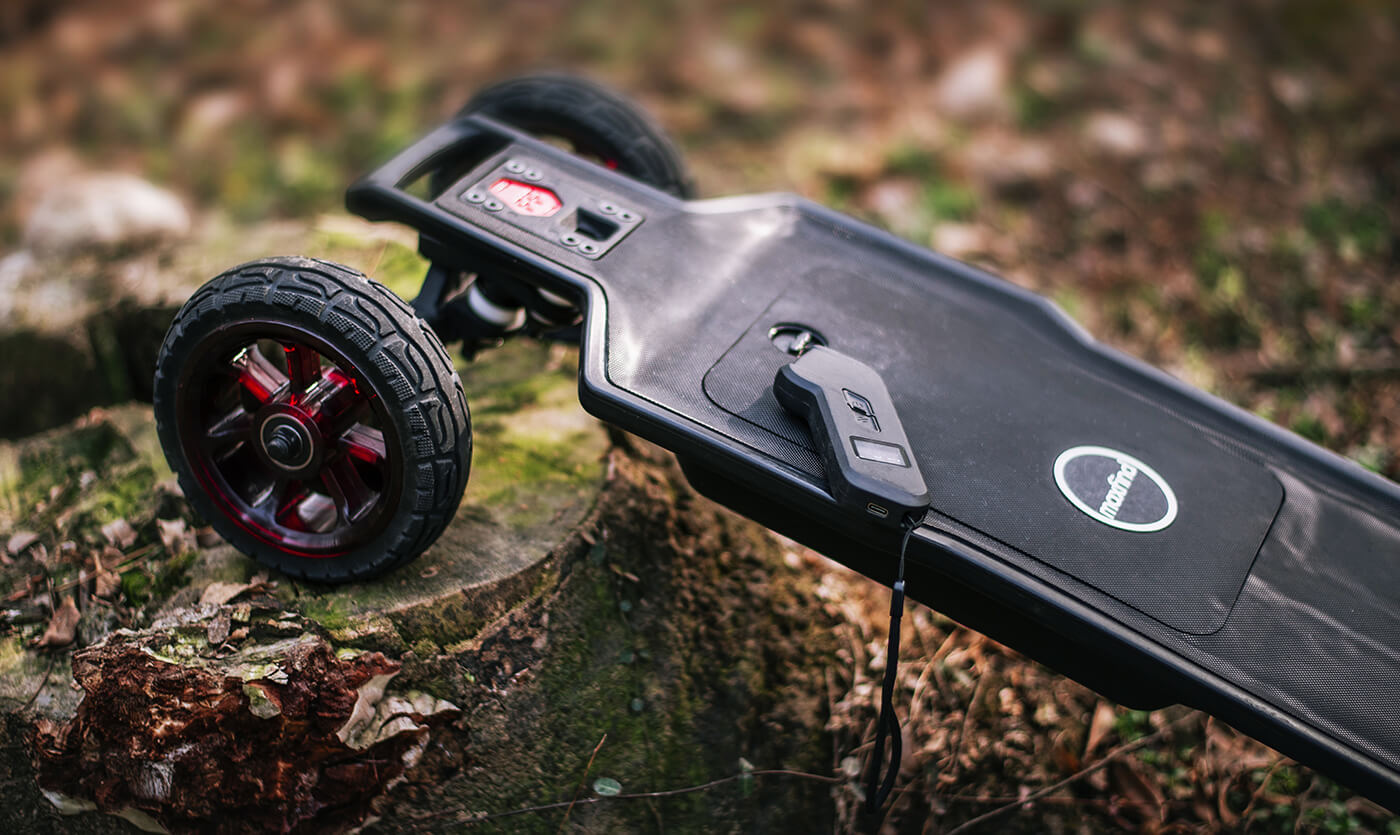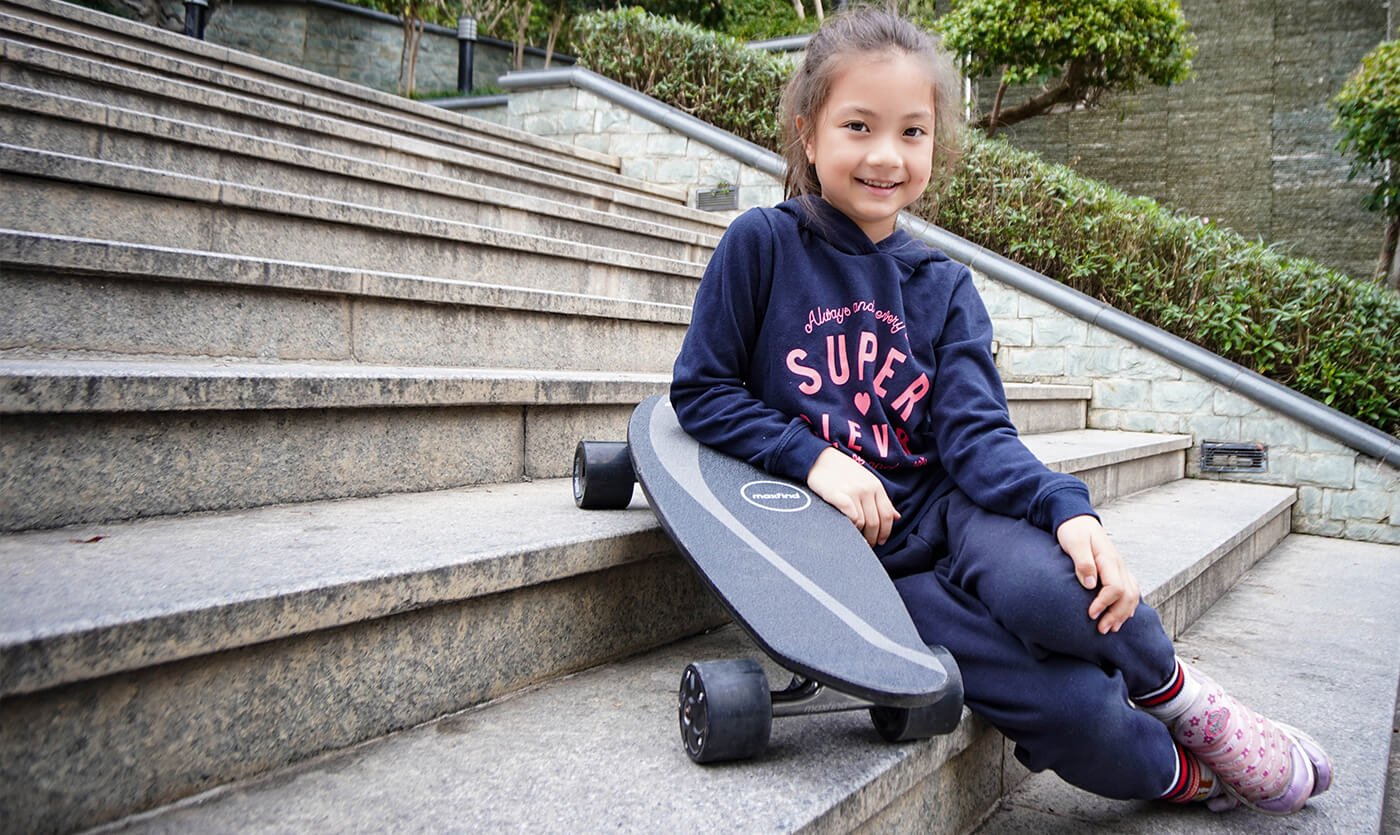If you love the idea of exploring new terrains on wheels, an all-terrain electric skateboard might just be the perfect fit. These boards are designed to handle rough, uneven surfaces—think gravel, dirt paths, and even sand—making them ideal for riders who want to skateboard beyond smooth streets. In this guide, we’ll walk you through the key features to consider when choosing an all-terrain electric skateboard, so you can make a smart, informed decision based on your specific needs and riding style.

Why Choose an All-Terrain Electric Skateboard?
All-terrain electric skateboards excel on dirt, gravel, and city streets, delivering control and speed across rough surfaces. They turn commuting and weekend rides into adventure with electric assist that reduces fatigue. Though pricier, their durability and versatility offer strong long-term value.
Key Features to Consider When Choosing an All-Terrain Electric Skateboard
1. Motor Power and Performance
When choosing an all-terrain electric skateboard, the motor power is one of the most crucial factors to consider. The more powerful the motor, the better your board will perform on tough terrains, especially when climbing hills.
A single motor might be sufficient for lighter, less challenging terrain, but a dual motor setup (usually ranging from 1500W to 3000W) provides more torque, allowing you to power through steep inclines and rough patches with ease.
If you’re planning on riding through hilly areas or need extra power for off-road adventures, a dual-motor board is the way to go.
2. Wheels and Tires
The size and type of wheels can make or break your experience with an all-terrain skateboard. Typically, all-terrain boards come with larger, pneumatic wheels (ranging from 6 to 9 inches) that offer better shock absorption and traction on uneven surfaces.
These wheels can handle gravel, sand, and dirt trails much better than smaller, harder wheels found on street boards.
If you’re planning to ride on soft, loose surfaces like sand or mud, look for a board with knobby tires, which offer better grip and control.
3. Battery Capacity and Range
Battery life is another key consideration. You’ll want to ensure that the skateboard’s battery has enough capacity to handle the distance you plan to ride.
Most all-terrain boards offer a range of about 10–20 miles per charge, but this can vary depending on the battery size and terrain type.
When considering battery capacity, think about how far you usually ride. If you’re just doing short trips, a smaller battery might be fine, but if you want to explore longer trails, a higher-capacity battery will give you peace of mind that you won't run out of juice mid-ride.

Additional Features for Comfort and Safety
1. Suspension and Shock Absorption
When riding over bumps, cracks, or gravel, suspension systems are critical for providing a smoother ride. Many all-terrain skateboards come with built-in shock absorption to reduce the impact of rough surfaces.
This is especially important for comfort on long rides or when navigating very uneven terrain. The two main types of suspension are spring-based and rubber dampers, each offering different levels of comfort.
Look for a board with good suspension if you plan on riding through forests, rocky trails, or any terrain where the ride might get a bit bumpy.
2. Braking System and Stability
Safety is always a top priority, and a reliable braking system is essential for all-terrain boards. Some boards come with regenerative braking, which helps recharge the battery while you brake, and others feature dual braking systems for better control and stopping power.
You also want a board with a solid deck and good grip tape to ensure that you maintain stability and control, especially on uneven or slippery surfaces.
Below is a practical breakdown of beginners, intermediates, and advanced riders—what each group needs, what to avoid, and how to pick the right All-Terrain Electric Skateboard for real-world riding.
How to Choose an All-Terrain Electric Skateboard
Beginners (first AT board or < 6 months riding)
Likely to ride 5–10 miles per session, light hills, mixed terrain.
What to choose
-
Wheels/Tires: 6–7" pneumatic or semi-pneumatic tires for easy roll-over.
-
Motors: Dual motors (not single) for predictable starts and hill help.
-
Drive: Belt (or gear) drive for better torque and easy tire options.
-
Battery/Range: Realistic 10–15 mi off-road; don’t chase max speed.
-
Deck/Trucks: Slightly stiffer deck + wider trucks for straight-line stability.
-
ESC & Brakes: Multiple beginner modes, gentle throttle curve, strong brakes.
What to avoid
-
Ultra-stiff race decks, tiny hard wheels, “top-speed” marketing.
Intermediates (6–24 months riding)
What to choose
-
Wheels/Tires: 7–8" knobby pneumatics for dirt/grass; consider a 2-in-1 kit to swap to street AT wheels.
-
Motors: Strong dual motors; prioritize torque over peak mph.
-
Drive: Belt or gear drive; sealed or guarded components for grime.
-
Battery/Range: Aim for 15–25 mi off-road (bigger pack, 12S+ voltage).
-
Deck/Trucks: Stable long deck; harder bushings or barrel/barr-cone for control.
-
Electronics: Advanced ESC tuning, customizable modes, reliable regen braking.
What to avoid
-
Under-volted packs for hilly routes, soft bushing setups at high speed, hub-only for loose terrain.
Advanced (technical trails, long descents, steep climbs)
What to choose
-
Wheels/Tires: 8–9" high-volume knobbies; consider foam/rim protection.
-
Motors: High-torque dual or performance gear drive; heat-managed cans.
-
Drivetrain: Sealed gear or belt with metal motor mounts and tensioners.
-
Battery/Range: Large, robust pack (e.g., high-capacity 12S/13S); target 20–35 mi off-road.
-
Chassis: Stiff, stable platform; wide precision trucks; shock-absorbing risers as needed.
-
Electronics: Pro-level ESC with fine-grained throttle/brake curves, thermal monitoring.
What to avoid
-
Street-only setups, minimal heat management, flexy decks at speed, unsealed bearings.

Why Choose Maxfind’s All Terrain Electric Skateboard?
If you’re ready to take the leap and want a reliable all-terrain electric skateboard for daily commuting or weekend adventures, check out our Maxfind FF AT All Terrain Electric Skateboard.
The FF AT is built for riders who demand both performance and comfort. With its dual motors delivering powerful torque, large pneumatic wheels for a smooth ride, and a high-capacity battery that supports long-distance journeys, it’s designed to handle gravel paths, dirt trails, and city streets with ease.
Other advantages include:
-
Strong Performance: Dual high-torque motors that climb hills and power through rough terrain.
-
Extended Range: A robust battery system that lets you explore longer distances without worrying about running out of charge.
-
Smooth & Stable Ride: Big pneumatic tires and a shock-absorbing deck for maximum comfort on any surface.
-
Safe & Reliable: Regenerative braking and sturdy construction to give you full control and peace of mind.
Whether you’re commuting to work or chasing adventure outdoors, the Maxfind FF-AT is a versatile all-terrain electric skateboard built to deliver long-lasting fun and dependable performance.
Common Problems and How to Avoid Them
Too Much or Too Little Power
Some riders might choose a board with too much power, resulting in an overly fast and difficult-to-control ride. On the other hand, opting for too little motor power could leave you struggling on rough terrain or inclines. Be sure to choose a motor that suits your terrain and riding style.
Uncomfortable Ride
If the board doesn’t have a good suspension system or if the wheels are too small, your ride may feel uncomfortable, especially on long trips. Look for boards with good shock absorption and larger wheels for a smoother experience.
Battery Issues
Another common problem is not accounting for the battery's range, leaving you stranded if it runs out of power mid-ride. Make sure you know the board’s range and always charge it before long rides.
Conclusion
Choosing the right all-terrain electric skateboard comes down to understanding your needs and how you plan to ride. By considering key factors like motor power, wheel size, suspension, and battery life, you’ll be well on your way to finding the perfect board for your next adventure. Test out different models, read reviews, and take your time to make a decision that aligns with your riding style, budget, and terrain preferences.
More Reading: FAQ for Beginners on Electric Skateboards






Share:
How Fast Do Mini E-Bikes Go?
Cruising Through Autumn: Why Electric Skateboards Are Perfect for Fall Adventures